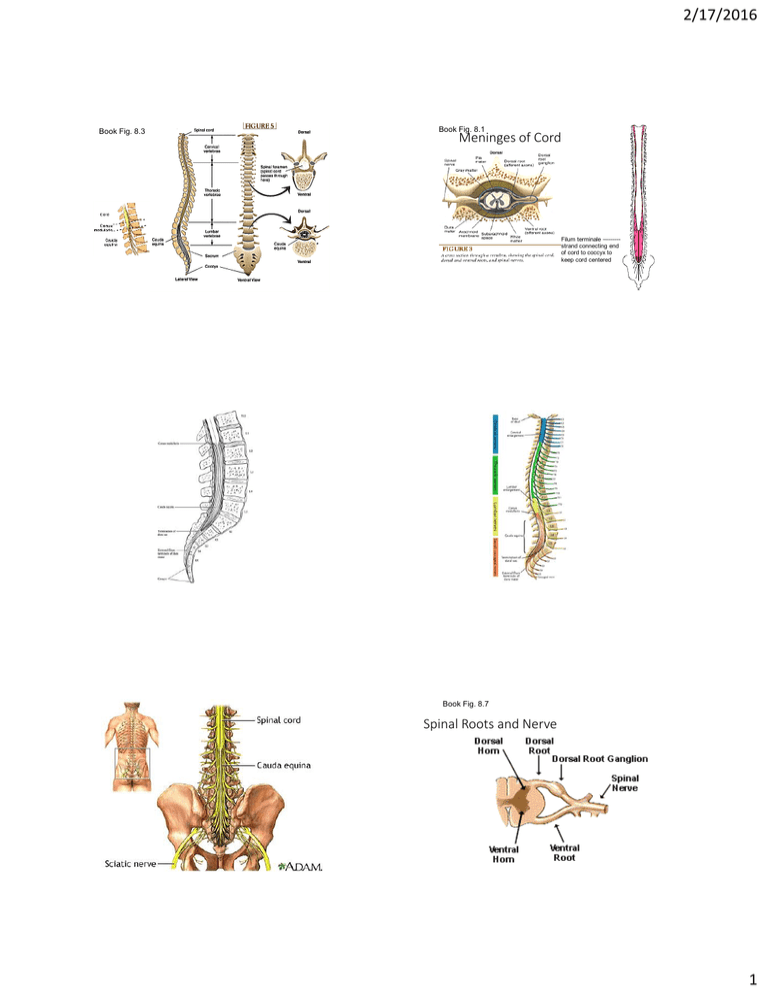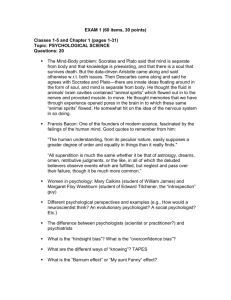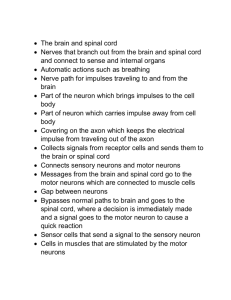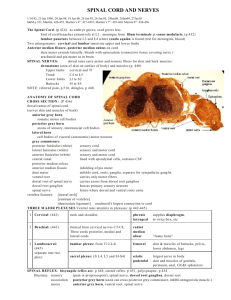2/17/2016 1 Meninges of Cord Spinal Roots and Nerve
advertisement

2/17/2016 Book Fig. 8.3 Book Fig. 8.1 Meninges of Cord Filum terminale –------strand connecting end of cord to coccyx to keep cord centered Book Fig. 8.7 Spinal Roots and Nerve 1 2/17/2016 How Sensory Input Enters Cord Once sensory message enters cord, it must travel up the cord to brain to trigger a conscious sensation. Dermatomes Book Fig 3.8 • The large amount of white matter in the spinal cord reflects the fact that one of its major functions is to serve as a “cable” between body and brain. We’ll first consider the incoming sensory pathways in this “cable” carrying sensory messages up the cord to brain. We’ll concentrate on those that go all the way to cortex, essential for conscious appreciation of sensations. White Matter Columns Book Figs 8.6 & 8.7 2 2/17/2016 Basic Organization of Ascending Somatosensory Pathways Ascending Tracts or Pathways “Afferent" tracts carrying sensory input up cord from body to brain 1st order • A series of 3 neurons is needed to get the message from body surface to cortex: • First-order neuron: carries input from skin to CNS (dendrites are sensitive to external stimulus, soma is in dorsal root ganglia, axon enters CNS & synapses on 2nd neuron) • Second-order neuron: axon of 2nd cell crosses to the opposite side of CNS & carries input up to the thalamus. Also sends a branch to the reticular formation to arouse us. • Third order neuron: Thalamus neuron relays input to the cortex. Third order neuron carries message from thalamus to somatosensory cortex Key Pathways Mediating Conscious Sensations • Why did I skip showing you the 2nd order neuron? Because the location and path traveled by the second neuron varies depending on the type of body sensation. We will cover 2 anatomically distinct ascending sensory pathways. • Dorsal column pathway – discriminative (detailed, fine) touch, proprioception (limb position/motion sense), & vibration. This tract is needed for us to feel & precisely locate light touch & do 2 point discrimination, stereognosis & graphesthesia (see next slide) • Spinothalamic pathways – pain, temperature and gross touch 3 2/17/2016 • Stereognosis – recognizing something by touch • Graphesthesia “feeling writing”– ability to identify the number or letter “written” on your body surface (a complex touch perception) Fine touch receptors =-8664637875260617379 Column of white matter between 2 dorsal horns extending up the entire length of the spinal cord See fig 8.9 C GG C A cervical cross section A sacral cross section 4 2/17/2016 Dorsal Column Pathway Book Fig. 8.14 • 1st cell’s axon enters dorsal column and travels all the way to medulla before synapsing • 2nd cell is medulla neuron whose axon crosses midline & heads to thalamus. Fasciculus gracilis and cuneatus • In the dorsal column the ascending axons are organized in an orderly fashion with sensations from lowest parts of body being carried by the most medial axons and those from uppermost regions carried by the most lateral axons (see next picture) • Collectively the axons from lower body= fasciculus gracilis; axons from upper body = fasciculus cuneatus Spinal Tracts Remember – labeled tracts are present on both right and left sides of cord even though diagram only labels one side. Mnemonic – Your ass is grass (gracilis) Particular part of thalamus for body sensation processing is the VPL thalamus Spinothalamic Pathway • Pain, temperature and gross touch • What’s different about this pathway? • 1st neuron synapses in dorsal horn as soon as it enters cord • 2nd neuron is a spinal neuron whose axon immediately crosses to other side of cord, then travels in the lateral white matter all the way to VPL thalamus 5 2/17/2016 8.16 8.17 Pain Chemicals • Injury to cells by any means leads to release of a variety of irritating chemicals (“an inflammatory soup” which activate and sensitize the dendrites of pain receptors. • Pain receptors not only pass on this message to the CNS, they also synapse on cells at the site of injury causing vasodilation (redness) and swelling. Irritation of Sensory Receptors What happens if you suffer damage to or deterioration of the dorsal column pathway? • As sensory receptors deteriorate, they may malfunction before they stop functioning causing paresthesia or dysesthesia (abnormal sensations like pain or pins & needles feelings). • E.g. in “tabes dorsalis” shooting, lancinating, electricallike or cramp-like pains occur, and in peripheral neuropathy unpleasant abnormal tingling, burning, tightness, & “pins & needles” paresthesias occur. • You’ve experienced temporary paresthesias when your arm or leg “falls asleep”; paresthesias from your hand is also one of the early signs of carpal tunnel syndrome 6 2/17/2016 Tabes Dorsalis (“dorsal decay”) or Syphilitic Myelopathy Tabes Dorsalis • Symptoms that appear decades after an untreated syphilis infection. • Dorsal column loses its myelin and deteriorates, causing abnormal sensations & loss of position sense • We use our proprioception/position sense to maintain our balance, position and muscle tone and become unsteady without it. Sensory Ataxia • Gait (walking) problems related to loss of proprioception following degeneration of dorsal columns and/or dorsal roots. • Watches feet while walking, feet tend to slap down; shows a “positive Romberg’s sign” (person sways and is unsteady if asked to stand with eyes closed) • Some reasons why one might lose dorsal column proprioception: • • • • Syphilis – “Tabes dorsalis” Vitamin B-12 deficiency Peripheral neuropathy (e.g. as seen in diabetics and alcoholics) Multiple sclerosis Similar loss of dorsal column path + additional loss of proprioceptive input to cerebellum (spinocerebellar path) occurs in other disorders like B12 deficiency or hereditary Friedreich’s ataxia Astereognosis • Another symptom of dorsal column damage • Without fine discriminative touch person cannot identify objects or textures by touch • Example: Can happen in tabes dorsalis or in MS if dorsal column loses its myelin • Romberg Test • An abnormal Romberg Test Congenital Insensitivity to Pain • No pain? Sounds wonderful. But you can’t imagine just how often and in how many ways you would damage your body and never heal if you got no painful warning signs or the soreness that makes you baby injuries while they are healing! • Recessive mutation of gene on chromosome 1 – sensory receptors for pain and temp fail to develop. Also leads to a failure of sweating so body overheats. What will happen to an individual who has irritation of or damage to the lateral spinothalamic pathway? 7 2/17/2016 Shingles (aka Herpes Zoster) (1 million cases/yr in US) • After chicken pox the virus (Varicella zoster) lies dormant in dorsal root ganglia. • It may “re-activate” if your immune system is weakened or stressed, or as you get older (most common after 50-60). • The first sign is tingling, burning or shooting pains, usually in a single unilateral dermatome. • A few days later a pox-like painful rash develops in that dermatome, lasting 4-5 weeks. Dermatome- Area of body surface providing sensory input to a nerve • When you had chicken pox virus migrated from skin to dorsal root ganglia where it can lie dormant for decades. • If it reactivates in certain ganglia, it migrates back out & causes shingles rash in that dermatome. • Affected pain receptors may remain sensitized, causing persistent pain. Herpes Zoster or Shingles Treatment • Antiviral drugs like acyclovir can shorten the attack & decrease complications if taken when the first signs appear. • Anti-inflammatory pain relievers • Zostrix (capsaicin) cream applied to unbroken skin also relieves pain by decreasing the supply of Substance P in pain receptors. • Shingles vaccination is recommended for those over 60 Painful aftereffects can far outlast rash Unfortunately nerve inflammation may persist long after the rash heals in some individuals, causing nerve pain called “post-herpetic neuralgia”. 8 2/17/2016 Another disorder affecting the spinothalamic pathway: Syringomyelia Syringomyelia • Enlarged CSF filled cavity within cervical spinal cord, most often associated with Chiari malformation (cerebellum bulging thru foramen magnum) • Cavity compresses and damages nearby tissue (like hydrocephalus of cord) • “Cape anesthesia”, loss of pain & temp sensation from hands, weakness cavity also affects ventral horns. • If severe, operate on malformation or shunt. MRI of Cavity The Special Case of Pain • Pain experienced does not just reflect activation of pain receptors. • Pain experience also depends on other influences on the activity of the spinothalamic pathway: • The “gate control” for the pain pathway 2nd cell in spinothalamic path 9 2/17/2016 Acupuncture is one of the things that “closes the gate”. Narcotics, TENS treatments, massage, liniments are others. Descending Pain Suppression Pathway • Brain can modulate or block pain messages depending on motivation, attention, expectanicies, etc • The brain cannot always properly represent the location of the pain. • Pain is experienced as coming from the “most likely” or most common location. Vertebra 10 2/17/2016 Intervertebral disc between vertebrae Cauda equina Example: Sciatica Herniated lumbar disc presses on spinal nerves, making them fire Most common symptoms: Leg pain and paresthesias even though cause is compression of the nerve near the spinal cord Referred Pain – we often experience pain from organs as if it were coming from the surface of body 11







